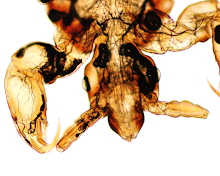Answer to the Parasite Case of the Week 628: Parasitic plant nematode eggs (e.g., Heterodera sp., Meloidogyne sp., Meloidogyne sp.); not a human parasite.
Sarah Sapp was the first to get this one (nice job Sarah!). She commented on our Creepy Dreadful Wonderful Facebook page that "I suspect this could be spurious passage of Meloidogyne (root knot nematode) eggs—size looks consistent, and also the very rounded ends with a concave broad side."
While we didn't identify the actual genus of the nematode, we can say with confidence that this is a plant nematode based on the larger size and distinctive shape:
This case is a great reminder that nematodes are all around us - free-living, or parasitizing living things besides humans - and they can occasionally be ingested by us and be seen in human stool specimens. This adds to our challenge of differentiating them and their eggs from similar-appearing human parasitic nematodes that may be found in human stool.














